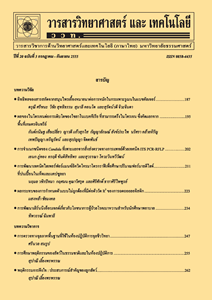ประสิทธิภาพของชีวภัณฑ์ในการควบคุมด้วงหมัดผัก (Phyllotreta sinuate) และหนอนกระทู้ผัก (Spodoptera litura) ในระบบการผลิตคะน้า
Main Article Content
Abstract
บทคัดย่อ
การศึกษาผลของการควบคุมแมลงศัตรูผักคะน้าโดยการใช้ชีวภัณฑ์ที่ผลิตขึ้นเองภายใต้สภาพแปลงผลิตผักคะน้าในพื้นที่อำเภอไทรน้อย จังหวัดนนทบุรี ประกอบด้วย 4 กรรมวิธี ได้แก่ การคลุกหรือไม่คลุกเมล็ดด้วยชีวภัณฑ์จากแบคทีเรียที่อยู่บริเวณรากพืชซึ่งทำหน้าที่ส่งเสริมการเจริญเติบโตของพืช (พีจีพีอาร์) Pseudomonas fluorescens เข้มข้น 1x108 cfu/ml อัตรา 2 กรัม ต่อเมล็ด 1 กิโลกรัม ตามด้วยการพ่นใบด้วยชีวภัณฑ์จากราก่อโรคของแมลง Beauveria bassiana เข้มข้น 1x108 spore/ml และ Bacillus thuringiensis (BT) เข้มข้น 1x108 cfu/ml อัตรา 20 กรัม ต่อน้ำ 20 ลิตร ทุก 7 วัน จำนวน 4 ครั้ง เมื่อคะน้าอายุ 7, 14, 21 และ 28 วันหลังปลูก เปรียบเทียบกับการปฏิบัติของเกษตรกรที่ยังคงมีการใช้สารเคมีและปุ๋ยเคมีและกรรมวิธีที่ไม่มีการควบคุมใด ๆ ซึ่งทุกกรรมวิธีถูกวางแผนการทดลองแบบ RCB กรรมวิธีละ 4 ซ้ำ ผลการทดลองพบว่ากรรมวิธีที่มีการใช้ชีวภัณฑ์จากพีจีพีอาร์และจากราก่อโรคของแมลงทั้ง 2 กรรมวิธี มีประสิทธิภาพในการลดประชากรด้วงหมัดผัก (Phyllotreta sinuata) และหนอนกระทู้ผัก (Spodoptera litura) ได้อย่างแตกต่างทางสถิติกับกรรมวิธีควบคุม (p=0.05) โดยในกรรมวิธีการปฏิบัติของเกษตรกรและกรรมวิธีที่ไม่มีการควบคุมใด ๆ พบศัตรูพืชทั้ง 2 ชนิด ระบาดเกินระดับเศรษฐกิจในบางระยะการเจริญเติบโตของผักคะน้า อย่างไรก็ตาม ปริมาณผลิตผลผักคะน้าจากกรรมวิธีที่มีการใช้ชีวภัณฑ์ทั้ง 2 กรรมวิธี ไม่แตกต่างทางสถิติจากการปฏิบัติของเกษตรกร (p=0.05) ยิ่งไปกว่านั้นยังพบว่าประชากรของ P. fluorescens, B. bassiana และ BT มีปริมาณเพิ่มขึ้นหลังมีการใช้ชีวภัณฑ์ชนิดต่าง ๆ และประชากรของจุลินทรีย์เหล่านี้จะลดลงหลังการเก็บเกี่ยวผลผลิต แสดงให้เห็นถึงประสิทธิภาพของชีวภัณฑ์ที่ผลิตขึ้นเองในการควบคุมแมลงศัตรูที่สำคัญ ได้แก่ ด้วงหมัดผัก และหนอนกระทู้ผัก ซึ่งสามารถนำไปประยุกต์ในโปรแกรมการจัดการแบบผสมผสานเพื่อลดหรือทดแทนสารเคมีป้องกันกำจัดแมลงศัตรูพืชและปุ๋ยเคมี ตลอดจนพัฒนาไปสู่ระบบเกษตรอินทรีย์หรือเกษตรยั่งยืนต่อไป
คำสำคัญ : จุลินทรีย์ปฏิปักษ์; ด้วงหมัด; ผลิตภัณฑ์จุลินทรีย์
Abstract
Study on the effect of insect pests control by our bioformulations on Chinese kale production under field conditions at Sai Noi Subdistrict Municipality, Nonthaburi province. Four treatments included 2 g/1 kg seed treatment with or without bioformulation of plant growth promoting rhizobacteria (PGPR), Pseudomonas fluorescens (1x108 cfu/ml) followed by 4-foliar-spray-intervals with 20 g/ 20 L water of bioformulations of insect pathogens, Beauveria bassiana (1x108 spore/ml) and Bacillus thuringiensis (BT) (1x108 cfu/ml) at 7, 14, 21, and 28 days after planting compared to farming practice that using agrochemical and synthetic fertilizer and non-treated control. All treatments were managed in RCB with four replications. Two treatments including seed treatment with or without PGPR bioformulation and foliar spray with insect pathogen bioformulations resulted in significantly reduced of flea beetle (Phyllotreta sinuata) and common cutworm (Spodoptera litura) when compared to the control treatments (p = 0.05). Insect pests were increased over economic threshold level at some growth stage of Chinese kale in farming practice and non-treated control but not in bioformulation treatments. However, marketable yield per rai of the bioformulation treatments and farmer practice were not significantly different (p = 0.05). Moreover, P. fluorescens, B. bassiana and BT populations in the soil were increased after bioformulations application and decreased after harvested time. This study illustrates the potential of our bioformulations to suppress both important insects. They could become a component of an integrated program to reduce or replace the application of synthetic insecticide and fertilizer in Chinese kale production system and developing for organic farming or sustainable agriculture.
Keywords: antagonistic microorganism; flea beetle; bioproduct


